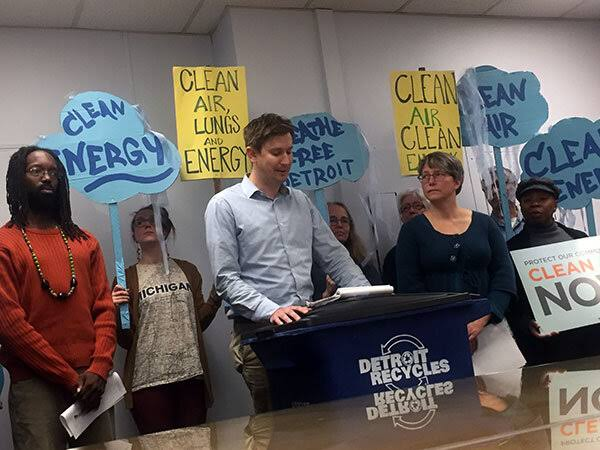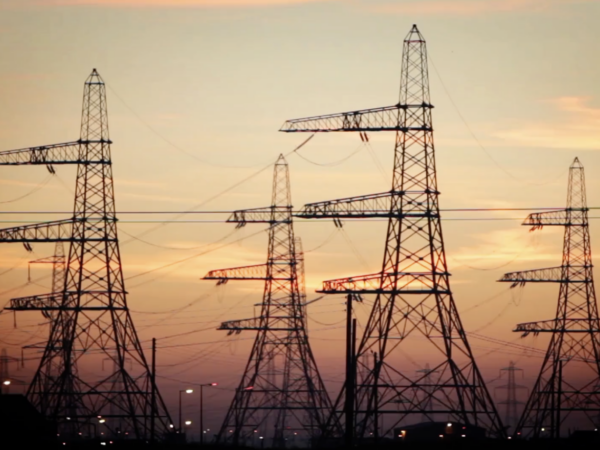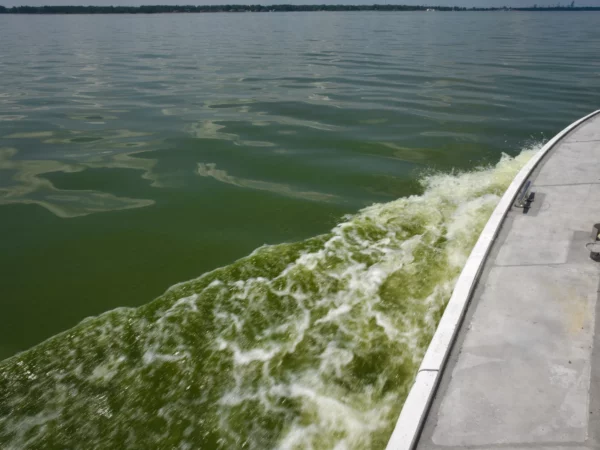
It’s a mistake, environmental law attorney Nick Leonard says, for Michigan to invest so heavily in private auto transportation in place of public transit options.
Leonard was referring to the billions of dollars in subsidies Michigan has recently budgeted primarily for electric vehicle (EV) production. Investment in public transit better serves lower income groups who don’t have resources to purchase EV’s and it’s the better option to deal with climate change, according to Leonard.
Leonard shared his views in a recent wide-ranging interview with Great Lakes Now. The backdrop is Michigan’s new Democratic majority that controls the governor’s office and the legislature which is moving fast to jumpstart EV production in the state.
Leonard also commented on the status of environmental justice programs under Gov. Gretchen Whitmer and his grievances with Michigan’s environmental regulating agency. Plus, he explained why politicians should not have been surprised when Michigan was the recipient of hazardous waste from the recent Norfolk Southern train derailment in Ohio.
Leonard is Executive Director of the Detroit-based Great Lakes Environmental Law Center.
The interview was conducted on the phone and via email. It was recorded, transcribed and edited for clarity and length.
Great Lakes Now: We spoke last November after the election when voters gave Gov. Whitmer a second term and Democrats a majority in the legislature. Since, their first priority has been on economic development subsidies in the billions of dollars primarily to Michigan auto companies for electric vehicle production. You’ve expressed a concern that the benefits of EV’s would be out of the reach of low income communities. Given the billions of dollars tossed at EV production and their expense, what are your thoughts now?
Related:
- Democrats in control: Advocates want action on justice, climate and “stronger leadership” from Gov. Whitmer
- Great Lakes, Chicago River and Asian carp in the spotlight in Elizabeth Kolbert’s “Under a White Sky”
Nick Leonard: Our concerns here are two-fold. Concern about who will be the user of the end-product, who will be able to access electric vehicles. Then, who will essentially bear the burden of the environmental risk that goes along with production of these vehicles. Because right now we’re seeing more attention to the first part of that equation.
The production issues obviously with our civil rights complaint regarding the expanded Stellantis auto assembly complex on the eastside of Detroit, which, not coincidentally received a great deal of public subsidization from both local governments, Michigan and Detroit.
Residents there feel like they were essentially sacrificed like we often talk about these communities as sacrifice zones. They feel like they’ve been sacrificed for the political capital that goes along with these things like the jobs politicians tout.
They feel ignored and a lot of the concerns they brought up before the facility was built were about odors, concerns about air pollution and the impact to the health of families. They feel those concerns have come to pass and that they were essentially right and they should have received closer attention.
On that front, we have a lot of work to do. The state of Michigan has a lot of work to do. We don’t have adequate processes or procedures within our laws and regulations and decision making processes regarding where these plants should be located, how they should be built and protections that should exist for local residents.
We don’t have the things I listed for environmental justice communities in particular regarding that question.
Concerning the access to EV’s, my understanding is that Gov. Whitmer is planning to take some steps to increase access for lower income people. I think they’re looking to expand their EV tax credit possibly to used cars, not new cars as It has been conclusively shown that higher income people buy new cars whereas lower to moderate income people buy used cars. It’s still a disappointing thing from the perspective of an environmental justice lens to be so heavily invested in EV’s while public transportation systems across Michigan, and inter-city public transportation is so lacking.
From an environmental justice perspective, it’s a mistake to be so heavily investing in private auto transportation in general, in lieu of public transit options.
The solution for low income people and the best climate solution is to have more robust intra-city public transit systems in the state’s major cities and a more robust inter-city public transit system that connects Michigan cities. These areas haven’t received adequate consideration and certainly not adequate resources.
GLN: You said that Gov. Whitmer in her first term had built a platform that could serve as a basis for action on climate, environmental justice and clean water now that Democrats control the government in Lansing. Are the governor and the legislature moving in that direction? Is anything happening?
NL: We’ll see, it’s still early and there are a lot of things under the environmental justice umbrella in terms of policy priorities and there is an ever shifting political landscape regarding these issues. Before a couple of weeks ago I would have said holding our electric utilities accountable wouldn’t have been a high priority for the Democratic legislature. But that reality may be rapidly changing based on the significant reliability issues that DTE keeps having in the wake of basically normal weather events in a Michigan winter.
Water affordability is an issue where the governor is looking to do something. There’s been a little bit of money allocated for shutoff protection and it’s an issue that’s been primed for several years.
The issue of cumulative impacts of pollution and ingraining that concept into environmental permitting could be on the agenda in the House, but I’ll believe it when I see it. That’s something that’s been talked about for so long and it hasn’t received the attention it deserves.
GLN: You were recently critical of Michigan’s Department of Environment Great Lakes and Energy (EGLE) and the U.S. EPA for delaying implementation of regulations in Detroit that would have improved air quality and public health. You said data was “cherry-picked” and that distorts the real picture. What’s going on?
NL: Essentially EGLE has submitted a request to the U.S. EPA to more or less ignore ozone pollution on two days in Summer of 2022. On those two days ozone pollution was above the National Ambient Air Quality Standards. They were at essentially unsafe levels.
If EGLE is not allowed to exclude those two days then the area would still be in non-attainment with the national ozone standard. EGLE claims that wildfire smoke from northern Canada impacted monitors that collect data therefore it should be allowed to ignore that data. If EGLE is successful it will pave the way for EPA to make the area in attainment despite the fact that air quality levels on the eastside of Detroit are above the national standard.
The lived reality of residents on the eastside of Detroit is that regardless of what EGLE says, the area has ozone levels above the standard and still at a dangerous level. That’s important in this community because three miles away is the zip code with the Stellantis auto assembly plant that was approved by EGLE and was heavily subsidized by the state of Michigan.
Also nearby is an area with the highest asthma hospitalization rate in Michigan. I believe over four times the state’s average rate. This is a significant environmental justice issue.
We often hear the complaint from EGLE that they wish they could do more on environmental justice but their hands are tied. That they’re bound by the laws and regulations that they’re required to administer.
EGLE’s request to exclude data for those two days is completely voluntary.
Under no circumstance is EGLE required to ask EPA to exclude any ozone data because it may have been impacted by wildfires. And EPA doesn’t have to approve it. EPA could basically find that regardless of what EGLE has submitted, it will still hold EGLE accountable to reduce ozone pollution. We disagree that wildfire smoke from Northern Canada had any impact on ozone pollution in Detroit and it’s disappointing that both EGLE and EPA are devoting departmental resources to avoid taking additional regulatory action.
This again seems to be a favor to the auto industry. If you look at the top four emitters of ozone pollutants in Michigan, all are auto assembly plants located in the Detroit area. And they could face more stringent emissions regulations if EGLE does not get its wish and the Detroit area remains in non-attainment.
It makes EGLE’s complaints about not being able to act on environmental justice ring hollow. Because here’s a clear decision point where they could decide to protect Detroiters on the east side by basically doing nothing.
Instead they’ve invested a significant amount of resources in trying to ignore data to get out of their regulatory commitments.
GLN: In early December, EGLE Director Liesl Clark abruptly left the Whitmer administration. You’ve been critical of EGLE on a number of fronts including the handling of Benton Harbor’s water issues and lax oversight and enforcement of laws in environmental justice communities. Is the lack of permanent leadership at EGLE an inhibitor to advancing environmental justice priorities?
NL: It could be. I think it’s a lack of a clear direction and commitment to environmental justice that is the issue. Liesl Clark was at least on some level, and some would say it was a superficial level, invested in environmental justice. She would regularly come to the Michigan Advisory Council on Environmental Justice meetings. She’d regularly attend work groups of departmental leaders meetings on environmental justice. It was clear that at some level the perception of being engaged on environmental justice was important, at least to her personally.
The problem was we never saw that translate to departmental action. That’s the main problem that is likely to remain regardless of who the leadership is. My feeling is that it is important to EGLE and the Whitmer administration to be perceived as being for environmental justice. I’m not so sure they want to move it along and do things that will achieve it. We haven’t seen those actions yet. The perception, yes.
Moving from perception to doing things is a whole other step. With the ozone issue they had a real opportunity to do something in reality and it wasn’t a heavy lift. It was basically stand by and do nothing and you’ve done something.
GLN: Hazardous waste disposal hit the headlines in Michigan in the aftermath of the Norfolk Southern disaster in Ohio. Michigan Rep. Debbie Dingell and others expressed public outrage that some of that waste was shipped to Michigan. In response you said there are broader, long-standing issues in play related to hazardous waste disposal. Can you elaborate?
NL: Hazardous waste was the genesis for environmental justice. Folks getting together in a national protest around a proposal to store toxic waste in a predominately Black community in North Carolina.
On the topic of hazardous waste we have a lot of research on this problem of toxic waste being stored, disposed of and treated in communities of color going back to the 1980’s when those protests originated.
We worked on this issue in the context of the U.S. Ecology facility on the east side in their license to expand their hazardous waste storage capacity.
What we found was that Michigan, in terms of commercial hazardous waste facilities, accepts most of its waste from outside of the state. Also, Michigan is the worst state when it comes to disproportionately siting commercial hazardous waste facilities in communities of color.
If you look at the people living within three miles of these facilities, 65% are people of color while only 25% of the state’s population as a whole. The important thing to note is that the problem of disproportionate siting has essentially remained unchanged more or less for the past 20 or 30 years.
This problem that we’ve known about and has existed for decades is an issue where environmental justice advocates have blown the whistle in 2007 and 2020. The reality in Michigan is that communities of color are serving as the dumping grounds for hazardous waste that’s coming from out of state everyday.
We should be in no way surprised about hazardous waste from a train derailment in Ohio coming to a site in Wayne County.
The takeaway is that unless our state agencies like EGLE and our legislators take action to end that legacy of environmental injustice and stop Michigan from being the dumping ground for hazardous waste, the problem will continue.
Related:
- Substantive change will require a ‘massive culture shift’ in federal, state and local agencies
- Michigan Gov. Whitmer’s plan needs to move from aspiration to action, says Detroit climate advocate
GLN: The continued unreliability of Michigan’s electrical grid has been on display recently with repeated power failures across the state. At some point, does state government have a role to play, an obligation to facilitate a remedy to the problem?
NL: You would think so. It’s certainly becoming severe enough where you would think the state government has to step in to basically fix what’s clearly becoming a system that’s not adequately regulating DTE, and it’s starting to impact people’s health, quality of life and financial well-being. Anytime you have people without heat in their homes in winter for up to seven days at a time, that’s a real crisis for families. There are undoubtedly countless people who had to find temporary shelter elsewhere.
The outages have put a light on the inadequacy of our current regulatory regime which is through the Public Service Commission. An environment now exists where it’s time for the legislature and the Public Service Commission to take a look and more seriously see what needs to change about this system both from a regulatory perspective and from the legislature’s perspective, is this the right system at all. That’s certainly a conversation that local governments are having and is one that state government should be exploring as well.
GLN: What’s the status of environmental justice in the Biden administration under EPA administrator Michael Regan? While EPA did a soft intervention in Benton Harbor at the request of a coalition that you led, it generally didn’t hold EGLE accountable? But in Chicago Regan intervened and used the gravitas of his office to influence a favorable decision for an environmental justice community. What’s your take on Regan in general and on environmental justice issues so far.
NL: He’s certainly done a lot of things that have made environmental justice advocates hopeful. Now, that said, the bar is set incredibly low. Environmental justice advocates are used to getting very little except for lip service. Just enough to create the perception that someone is doing something on an issue.
We’ve seen things like the environmental justice tools. Basically documents saying here are things we could do on environmental justice. That’s well and good and is necessary, but a tool box is no good if you’re not using it and to date we haven’t seen EPA use it that much.
There are some positive signs of action here and there like his intervention in Chicago. What we’re still waiting for is systemic change, like what are the things that will last beyond this administration?
Catch more news at Great Lakes Now:
As agencies seek more environmental justice data, longtime residents are skeptical
Illinois environmental justice bill would help residents prevent pollution
Featured image: Great Lakes Environmental Law Center executive director Nick Leonard speaks at at event. (Photo Credit: Great Lakes Environmental Law Center)




